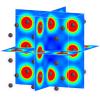当前位置:
X-MOL 学术
›
Phys. Rev. Materials
›
论文详情
Our official English website, www.x-mol.net, welcomes your
feedback! (Note: you will need to create a separate account there.)
Grand canonical approach to modeling hydrogen trapping at vacancies inα−Fe
Physical Review Materials ( IF 3.1 ) Pub Date : 2020-06-22 , DOI: 10.1103/physrevmaterials.4.063804 E. R. M. Davidson , T. Daff , G. Csanyi , M. W. Finnis
Physical Review Materials ( IF 3.1 ) Pub Date : 2020-06-22 , DOI: 10.1103/physrevmaterials.4.063804 E. R. M. Davidson , T. Daff , G. Csanyi , M. W. Finnis

|
Vacancies in iron are hydrogen traps, important in the understanding of hydrogen embrittlement of steel. We present a grand canonical approach to computing the trap occupancy as a function of both temperature and hydrogen concentration from practically zero to supersaturation. Our method couples a purpose-made machine-learned H-Fe potential, which enables rapid sampling with near-density-functional-theory accuracy, with a statistical mechanical calculation of the trap occupancy using the technique of nested sampling. In contrast to the conventional assumption (based on Oriani theory) that at industrially relevant hydrogen concentrations and ambient conditions vacancy traps are are fully occupied, we find that vacancy traps are less than fully occupied under these conditions, necessitating a reevaluation of how we think about “mobile hydrogen” in iron and steel.
中文翻译:

在α-Fe中空位处的氢俘获建模的经典方法
铁中的空位是氢陷阱,对理解钢的氢脆很重要。我们提出了一种宏大的规范方法来计算陷阱的占有率,它是温度和氢浓度从几乎为零到过饱和的函数。我们的方法结合了专用的机器学习的H-Fe势,该势能以接近密度泛函理论的精度进行快速采样,并使用嵌套采样技术对陷阱的占用进行统计机械计算。与传统假设(基于Oriani理论)相反,在工业上相关的氢气浓度和环境条件下,空位陷阱被完全占据,我们发现在这些条件下空位陷阱比完全被占据的情况要少,
更新日期:2020-06-22
中文翻译:

在α-Fe中空位处的氢俘获建模的经典方法
铁中的空位是氢陷阱,对理解钢的氢脆很重要。我们提出了一种宏大的规范方法来计算陷阱的占有率,它是温度和氢浓度从几乎为零到过饱和的函数。我们的方法结合了专用的机器学习的H-Fe势,该势能以接近密度泛函理论的精度进行快速采样,并使用嵌套采样技术对陷阱的占用进行统计机械计算。与传统假设(基于Oriani理论)相反,在工业上相关的氢气浓度和环境条件下,空位陷阱被完全占据,我们发现在这些条件下空位陷阱比完全被占据的情况要少,










































 京公网安备 11010802027423号
京公网安备 11010802027423号